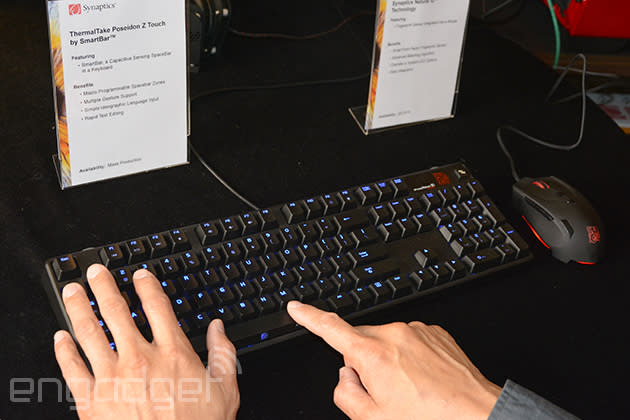Watch Synaptics' touch-sensitive space bar in action

Earlier today, Synaptics announced its SmartBar technology that adds a touch input area -- enabled by a sub-0.2mm-thick PET film -- onto the space bar, which then lets you perform certain tasks without having to touch the mouse or trackpad. We went over to the company's show room at Computex to check this out, and we came away impressed. In the first demo, we looked at how you can quickly select text while typing by simply swiping to the left on the space bar. We were then shown how you can scroll with two fingers on the space bar: hold down one on the left and swipe with another on the right for vertical scrolling, and vice versa for horizontal scrolling. This will take some getting used to, obviously. You can also zoom in and out by swiping both fingers inwards or outwards -- a bit like pinch-to-zoom but on a space bar.

Last but not least, in the companion desktop software, you can assign up to five zones (you can adjust the size of each) on your space bar with different macros. This is basically why gaming peripheral maker Thermaltake wants in on this, because apparently having dedicated macro keys dotted around a gaming keyboard isn't ideal. Well, we'll let the professional gamers be the judges here; they'll be able to buy a SmartBar-enabled keyboard from Thermaltake in early Q4 this year.
According to Synaptics, it's also looking into the feasibility of adding SmartBar to the backspace key and shift keys, as well as finding out if keyboard makers have interest in implementing a two-dimensional SmartBar on an oversized space bar, thus effectively turning it into a trackpad to accommodate more advanced gestures.

The company also showed off an upcoming Thermaltake mouse that has an integrated fingerprint reader, which allows super fast Windows login authentication. Much like the keyboard, this mouse is expected to launch some time in Q4. Looking further ahead, Synaptics is developing an under-glass fingerprint sensor solution for the sake of aesthetics on mobile devices, though this won't be ready for another 10 to 12 months.

